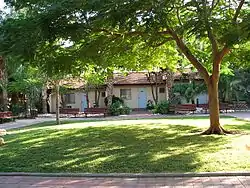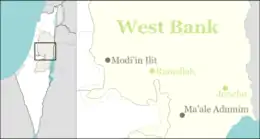Almog | |
|---|---|
 | |
 Almog | |
| Coordinates: 31°47′23″N 35°27′40″E / 31.78972°N 35.46111°E | |
| District | Judea and Samaria Area |
| Council | Megilot |
| Region | West Bank |
| Affiliation | Kibbutz Movement |
| Founded | 1977 |
| Founded by | Nahal |
| Population (2021)[1] | 255 |
Almog (Hebrew: אַלְמוֹג, lit. Coral) is an Israeli settlement in the West Bank, near the northwestern shores of the Dead Sea, in the Jordan Rift Valley, organized as a kibbutz. It is under the jurisdiction of the Megilot Regional Council. In 2021 its population was 255. The international community considers Israeli settlements in the West Bank illegal under international law, but the Israeli government disputes this.[2]
History
According to ARIJ, in 1977 Israel confiscated 524 dunams of land from the Palestinian site of Nabi Musa in order to construct Almog.[3]
Initially established as a Nahal settlement in 1977, Almog became a kibbutz in 1979. It was named after Yehuda Kopolevitz Almog, a Third Aliyah pioneer who founded the potash mining industry which developed into the Dead Sea Works in Sodom.[4] In the 1930s, Almog was one of the founders of the nearby kibbutz Beit HaArava.
Economy
The kibbutz runs a guesthouse and spa. On the grounds of the kibbutz is a small museum displaying copies of the scrolls found in Qumran. The kibbutz grows a variety of experimental crops for export.[5]
References
- ↑ "Regional Statistics". Israel Central Bureau of Statistics. Retrieved 22 February 2023.
- ↑ "The Geneva Convention". BBC News. 10 December 2009. Retrieved 27 November 2010.
- ↑ An Nabi Musa Locality Profile, ARIJ, p. 7
- ↑ Dead Sea Works
- ↑ Economy of Almog